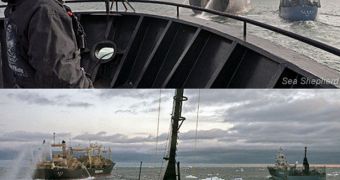The latest report from the Sea Shepherd Conservation Society (SSCS) shows that the Japanese whaling fleet, which is conducting illegal operations in the Southern Ocean Whale Sanctuary, is on the run.
After being discovered about five days ago, the Nisshin Maru factory ship and the Yushin Maru No. 3 harpoon vessel are currently trying to escape both the Bob Barker and the Gojira. These ships are part of the SSCS fleet involved in operation 'No Compromise.'
According to the conservation group, the two Japanese vessels have recently exceeded the eastern boundaries of their traditional whaling grounds. The whereabouts of the other two harpoon vessels making up the Japanese fleet is currently unknown.
The reason why the SSCS is not searching for those ships is because harpoon vessels cannot carry large numbers of whales. They must return to the larger factory ship, and load the carcasses through a ramp located at the stern of the Nisshin Maru.
This is now impossible, given that the Bob Barker maintains a course directly behind the Japanese factory ship. It would literally be impossible for a harpoon vessel to unload it cargo onto that ship.
In addition, the Gojira – a high-tech, high-speed trimaran – is searching surrounding grounds for the two harpoon vessels. The third SSCS ship, the Steve Irwin, is currently on an interception course with the main Japanese vessels, coming out of Wellington, New Zealand.
Generally, the eastern boundary of the Japanese whaling operations is 145 degrees west. But the factory ship and its escort are currently moving in a roughly eastward direction, at a speed of about 14 knots.
Right now, the four ships are at 72 degrees south and 133 degrees west on a course of 145 degrees, which means that they are a lot closer to South America than Australia and New Zealand. The vessels are now some 1700 miles southwest of Patagonia, Argentina.
“It’s like [the sailors on the Nisshin Maru] spin the bottle every watch to see what course to set. There is no rationality in these course changes,” explains Captain of the Bob Barker Alex Cornelissen.
“They go east, then south, then west, then north and then back east again. In short, they are burning quite a bit of fuel, going absolutely nowhere, and without being able to kill a single whale,” he adds.
As the SSCS discovered the Japanese whaling fleet very early this year, the whalers have had little chance to carry out their mission. They only killed a handful of whales, as they've been too busy trying to get rid of Sea Shepherd vessels.
The profits the so-called Institute of Cetacean Research gets from selling whale meat illegally in Japanese stores will take the most massive hit to date. If the activists keep it up in the coming years, than it will simply make no financial sense for the Japanese to continue their activities.

 14 DAY TRIAL //
14 DAY TRIAL //